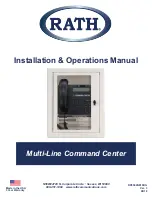
CHAPTER 1 Overview
C435HD Users & Administrator's Manual
365 services and AudioCodes' managed services such as the One Voice Operations Center
(OVOC).
Without a Web browser, malicious user/users will not be able to access the device and browse
from it as a trusted device into the customer network.
Remote Configuration Management
AudioCodes Native Teams devices do not have an embedded Web server. Configuration and
management are performed using one of the following remote interfaces:
■
Microsoft Teams Admin Center (for Native Teams devices) over HTTPS protocols, enabled
after a successful sign-in authentication process.
■
AudioCodes Device Manager (part of AudioCodes' OVOC suite) over HTTPS.
■
Debugging interface over SSH. Note that SSH must be disabled by default and enabled
only per specific case for debugging purposes only.
AudioCodes Device Manager Validation
The AudioCodes Native Teams devices validate the AudioCodes Device Manager identity using
a known Root CA:
■
The device is shipped with known Root CAs installed. See
AudioCodes Root CA Certificate
■
For the initial connection, the AudioCodes Device Manager accesses devices using a
known CA.
■
Once a successful secured connection has been established between the device and the
Device Manager, the user can replace the Root CA on the Device Manager and on the
phone, and re-establish the connection leveraging any Private Root CA.
Sandboxing
AudioCodes Native Teams devices use Android Application Sandbox so that each application
can access its own data and is isolated from other applications. This prevents a malicious app
from accessing the code or the data of other applications in the system.
Device File System
The AudioCodes Native Teams device's file system is encrypted on the C470HD, C435HD and
C450HD-DBW devices. Customers may enforce a policy of device encryption via Microsoft's
cloud-based Intune service.
Keystore
With AudioCodes Native Teams devices, the certificate keys are encrypted on the device file
system.
- 7 -













































